Do You Already Know This Concept?
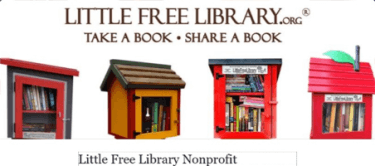
If so Check THIS out..

What started as a small, simple summer project has become a community builder, physical activity provider, learning opportunity, and most of all…a platform for FUN. When I decided to build what is basically a sports and activity locker that also serves as a free library, a few things soon became apparent.
Building Something, Seeing progress
In teaching, we have a conveyor belt of students and even when tracking student progress, it takes time to see change. With this project I was able to see tangible progress day to day. It had a reinforcing and unexpectedly positive impact on me, which helped keep me going. Neighbors would stop by as they walked their dogs each day and check in to see my progress. It was so much fun to talk to them, especially as they tried to guess what I was building in my driveway. Guesses include a closet, a sauna, and a box among others.
Community Building
My wife and I are new to our community and live across the street from a park. From our window, we see many people walk by and access the park. Over the two weeks I worked on the project we met many neighbors, some for the first time. Now, having this box filled with sports equipment in front of our house, people come up to us all the time with huge smiles and share how excited they are to have it on the corner and how they use it and see others doing the same. Each time we chat, I feel a huge smile inside because to me it’s about PLAY. All of us like to play, adults and children regardless of age. And it reinforces my reasons for becoming a physical education teacher: teaching students skills, providing them access to sports and activities, helping them develop the fitness they need to play games and activities, and encouraging them to play.
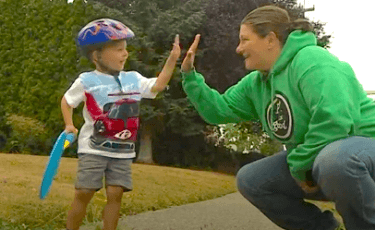
Promoting Physical Activity
Providing opportunity is the key to promoting physical activity. This has been a pillar of providing the Little Free Sports Library: Anyone can take equipment. My personal philosophy is that if they return it great, if they take it home and don’t bring it back what is the worst that has happened? They are playing in their yard with something active rather than in front of the TV or an electronic device. I’m okay with that and will continue to restock the Library. I’ve had some parents tell me that it has now become their routine to come up to the library during their daily walks, and others have said that their children have tried a new activity. I’ve seen more children get equipment and return it than I ever expected, and consequently more activity and fun! I have also seen adults come and borrow frisbees and footballs and play in the streets. It has been excitement for all!
What I Learned
- Construction skills – I’m an Adapted Physical Education teacher and don’t have formal training in construction or woodworking. I started out with only a little experience with tools, wood and equipment, but I had never tackled a large project.
- Being self-sufficient – To start out I needed to learn how to build my project
- Research- I spent many hours on the internet, YouTube, and looking at blueprints.
- Trial and error- I made mistakes, then had to readjust and make changes. Just like in teaching, things are rarely perfect at the start. But we take our lessons, reflect and improve.
- Ask neighbors – To really produce the best product I had to lean on others: the network of my neighbors, many of whom were more than happy to assist and become part of this greater good.
- Lifelong learning – It was an amazing experience for me to be a learner again and not a teacher.
It’s been such an amazing learning process for me to build the Little Free Sports Library. I’ve taken this experience and think of it as parallel to my knowledge and experience in adapted physical education. It’s reenergizing to step outside the place you have expertise and learn something new. This year I’ve been committed to and busy with presentations, work, and everything focused on adapted physical education. It was a nice change to do something with my hands, build something, and see immediate progress. And as I went through building the Little Free Sports Library, I discovered how similar it was to my work in education.
- I started with my end goal and backwards planned
- I went through a learning curve and tapped into my resources
- It took a community to support my progress
- You don’t know the impact you have

Planning the Size and Scope of the Project
I knew I wanted to have frisbees, balls, and rackets, so I built from there. After the process began, I learned that having even measurements would have helped me, rather than just going off sports equipment measurements. As you see in the picture above, I also try the amazing Pinterest idea of re-using wood pallets. It took half a day to take them apart and I found that I barely had the wood I needed! In teaching, sometimes we try too hard to reuse games, activities and curriculum. A better approach would be to step back and see what our end goal is, then look at the resources we have rather than trying so hard to reuse things.

Building a Solid Foundation and Frame
This is where I learned what a “King Stud” was. As in learning about anything these days, I reverted to the Internet, did a little investigating and figured out how to frame the structure and set up having a door. I find that a lot of information about working with students with disabilities can also be learned this way. In teaching and in construction there is a lot of information available and some of it is very similar: Start out constructing a solid foundation and frame build on.
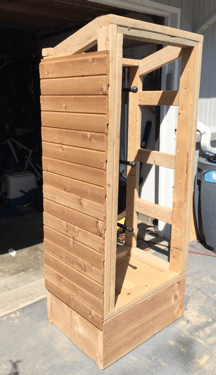
Get the Right Equipment
As I was putting on the cedar siding, I realized how much difference having the right equipment makes. I was cutting each piece with my circular saw, when my neighbor came over and invited me to borrow his miter saw. Wow, what a difference in cuts, precision, and work effort productivity! I could have done it with the circular saw but realized that as in our teaching with students, equipment can and does make a difference. Yes, we can get by and with imagination improvise, but in this construction project and in my adventure races, I’ve learned that quality equipment can have an impact on your product.

Learning from Experience: A Door for All Seasons
The entire project took a bit of creativity and elbow grease. I wanted people to see into the library, and I used plywood. One season later I’m realizing I will be doing some rebuilding. Plywood – at least the type I used – proved not a durable material and after a wet and snowy Seattle winter there is a little damage to fix up.
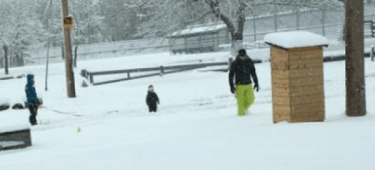
Play On…
Even during a massive winter Seattle snow storm the play continues. Soccer in the streets, jump ropes pulling sleds, frisbees flying, the fun never ends. All we need to do is to provide our communities the opportunity.
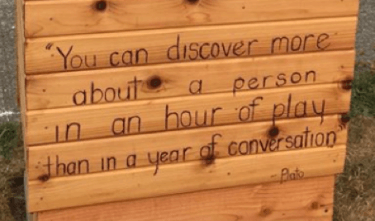
What’s the Impact?
You never know your impact. Sometimes it comes at the unexpected times. I don’t worry too much about it. To me it is about just being active, all ages, all abilities.
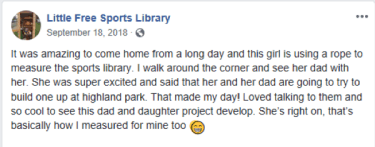
Positive Press
Positive messages about taking and using the equipment and positive press brings the community together. The videos have exploded. I never imaged building a hands-on project that has been so enthusiastically embraced by my community of over 4,600 people. Join me and let’s get Little Free Sports Librariespopping up across the nation! Please follow us on Facebook @LittleFreeSportsLibrary and share your own success stories.
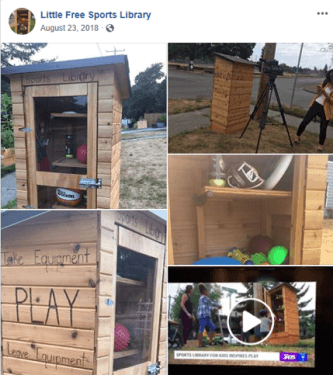
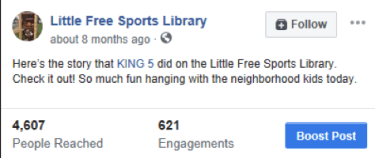
Links to News Stories
King 5 news- https://www.king5.com/article/news/local/little-free-sports-library-brings-west-seattle-families-together/281-587088764
Q 13 Story – https://www.facebook.com/littlefreesportslibrary/videos/1644817625627370/
~Please post your thoughts and comments in the discussion section below this article~

Toni Bader is amazing!